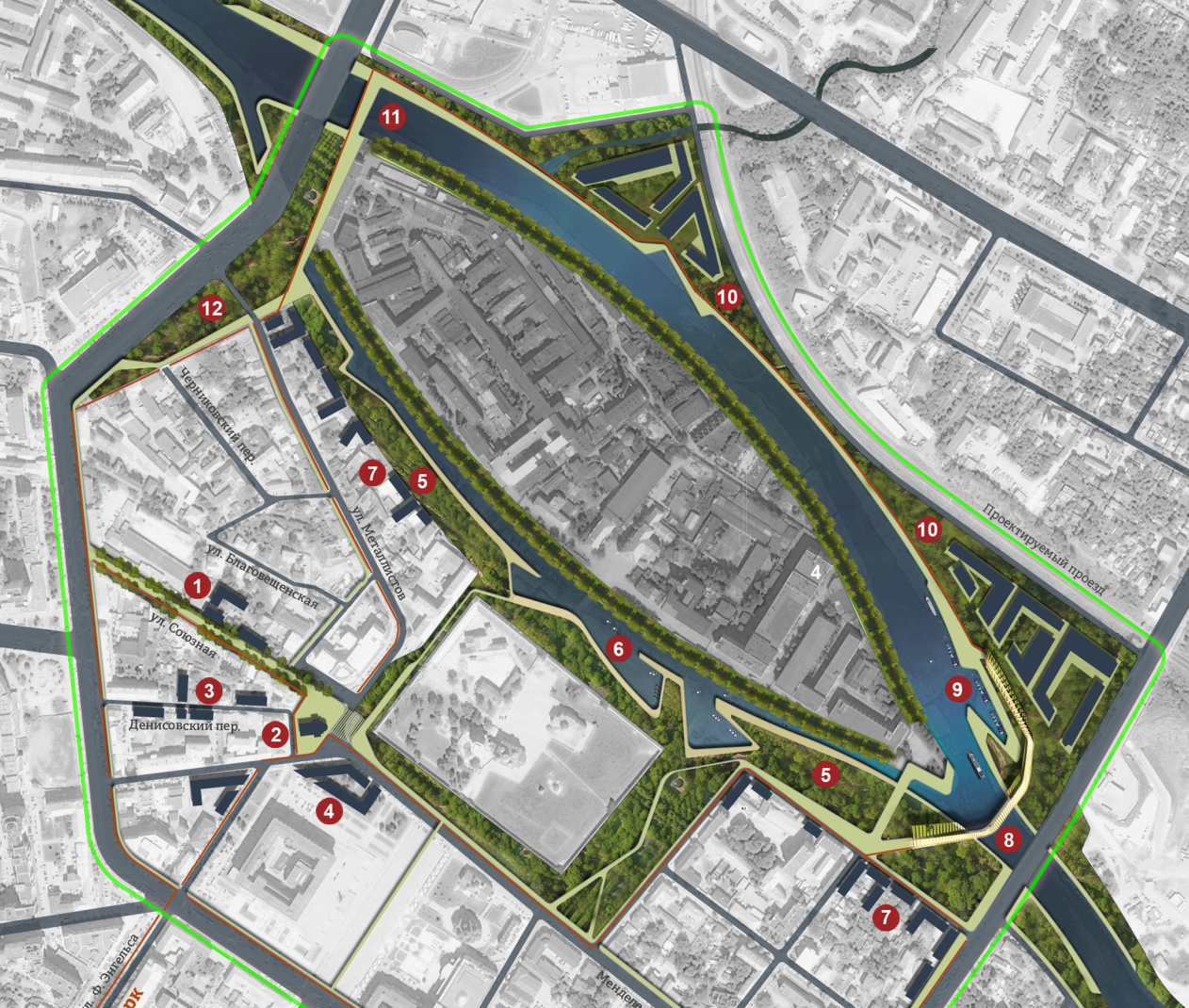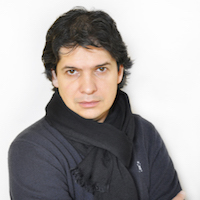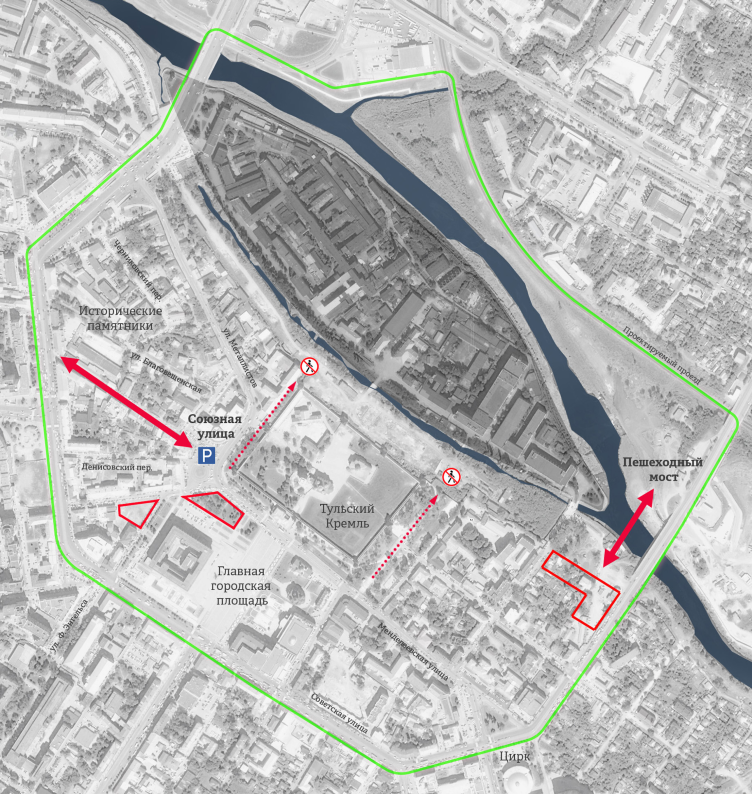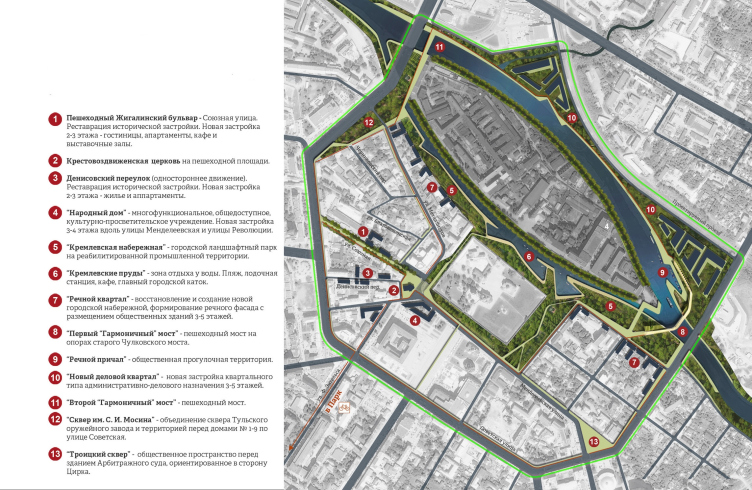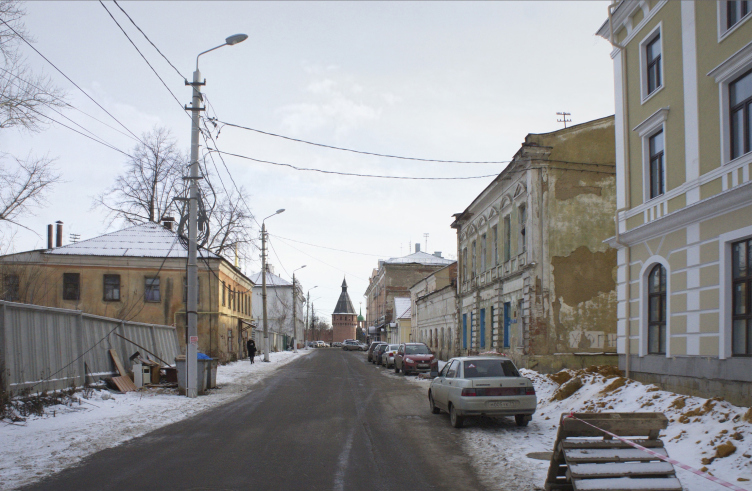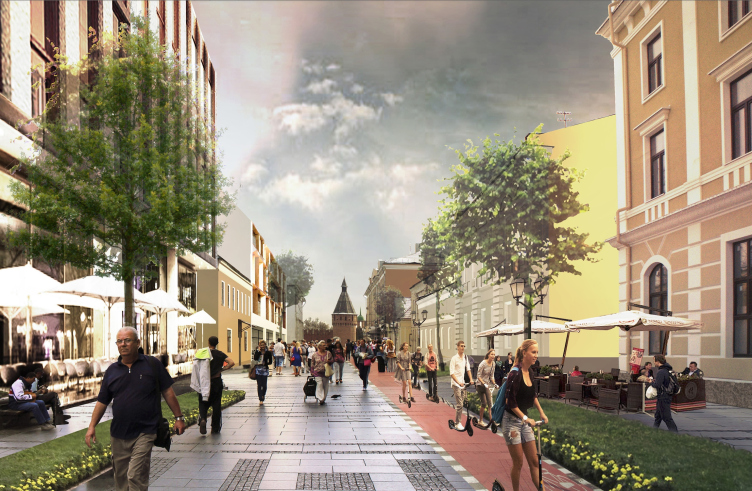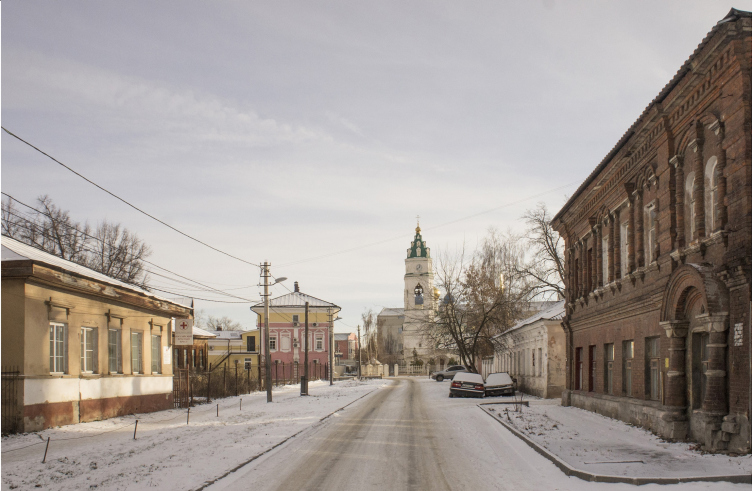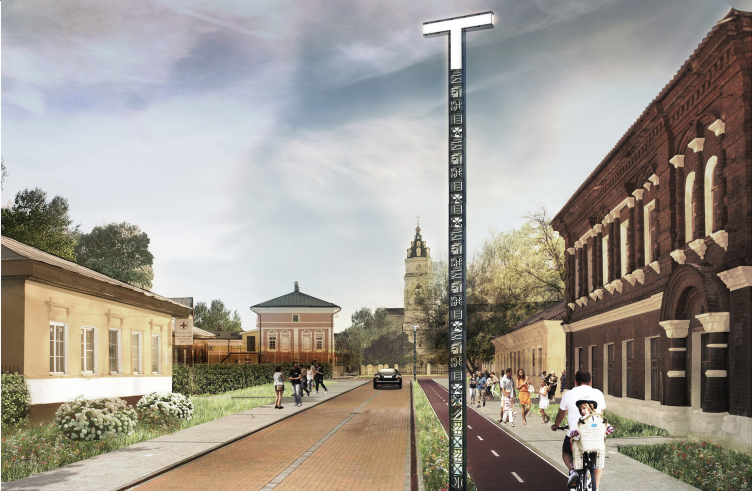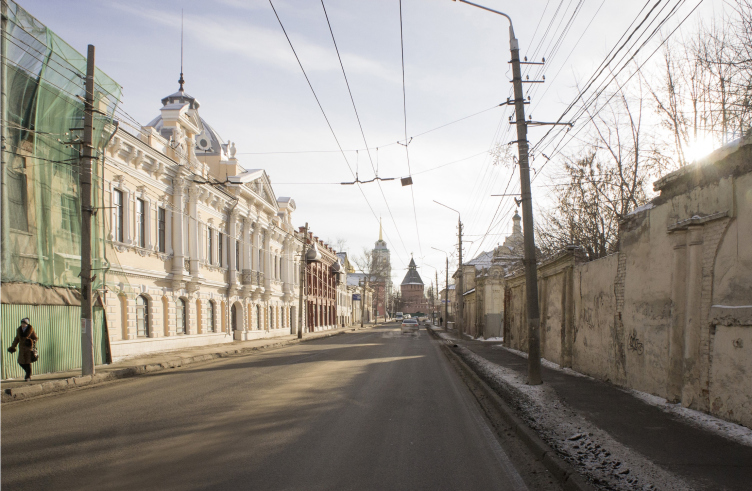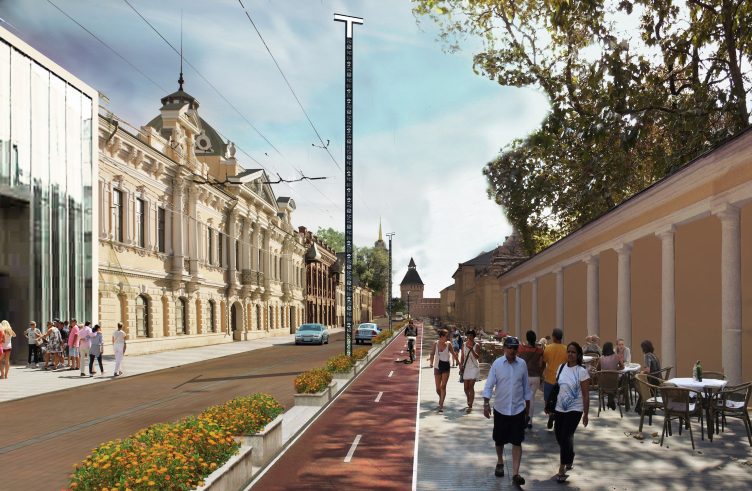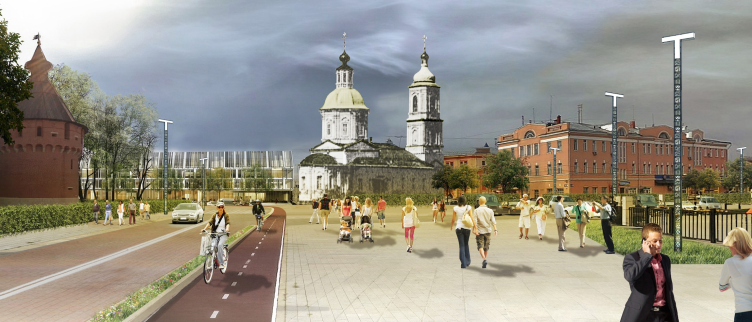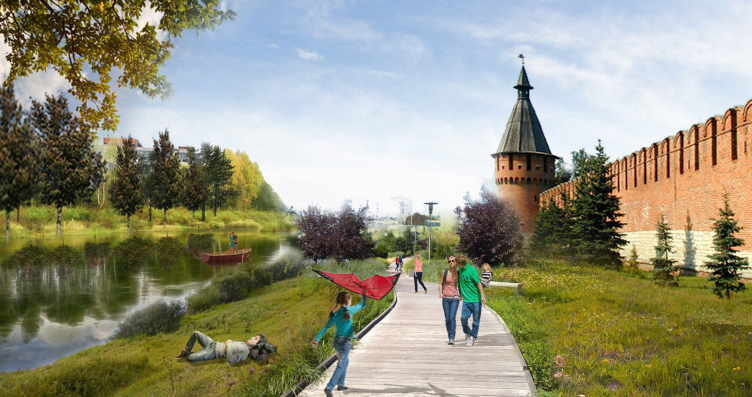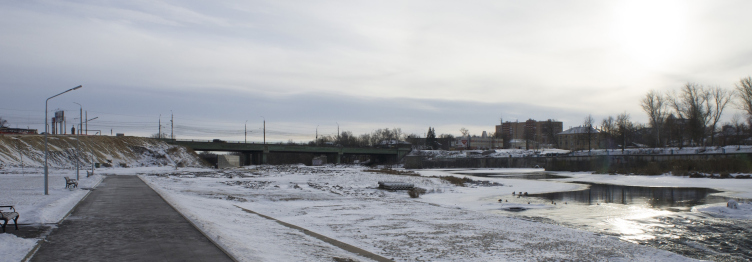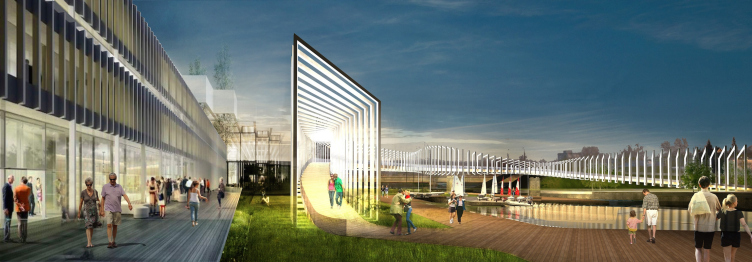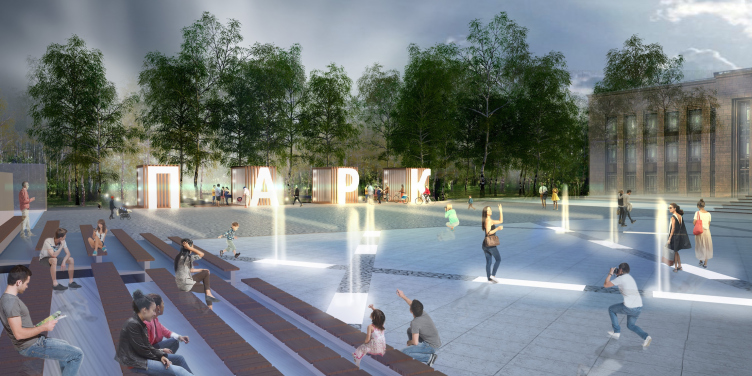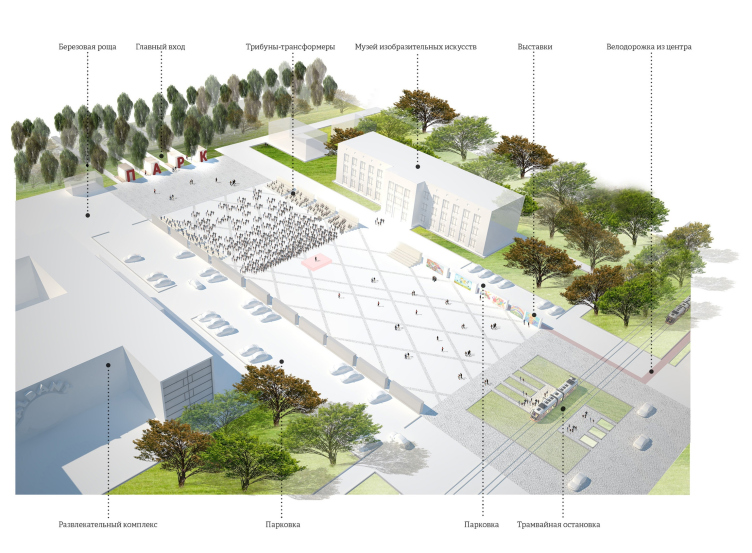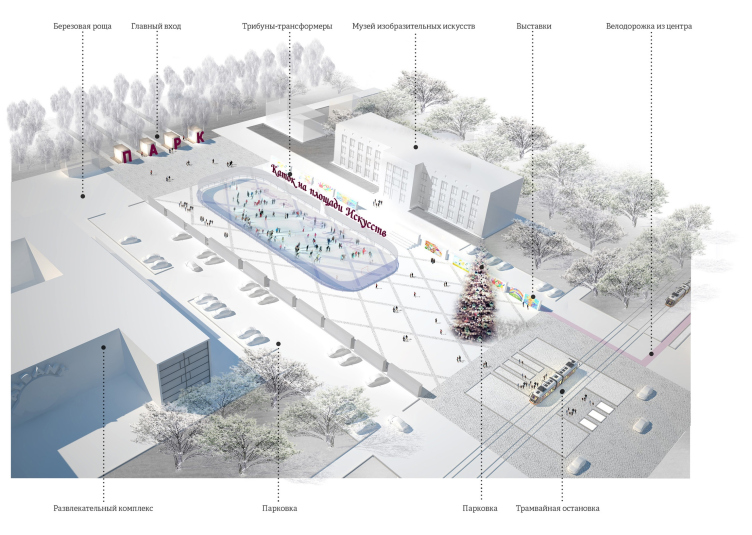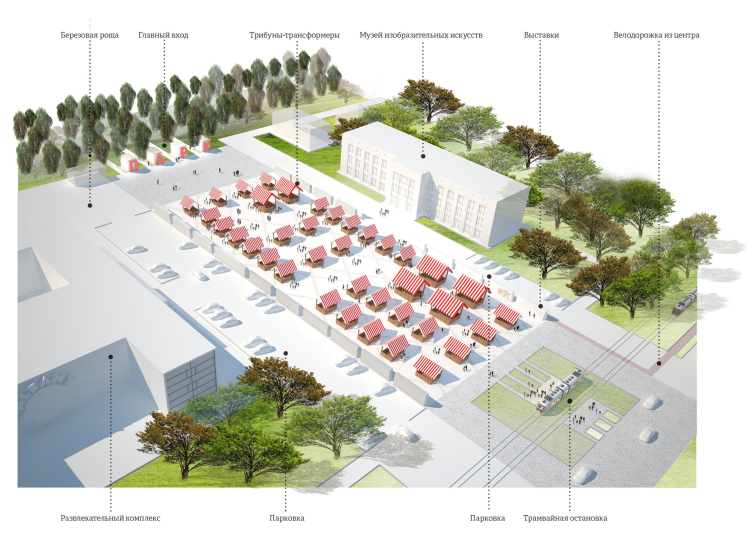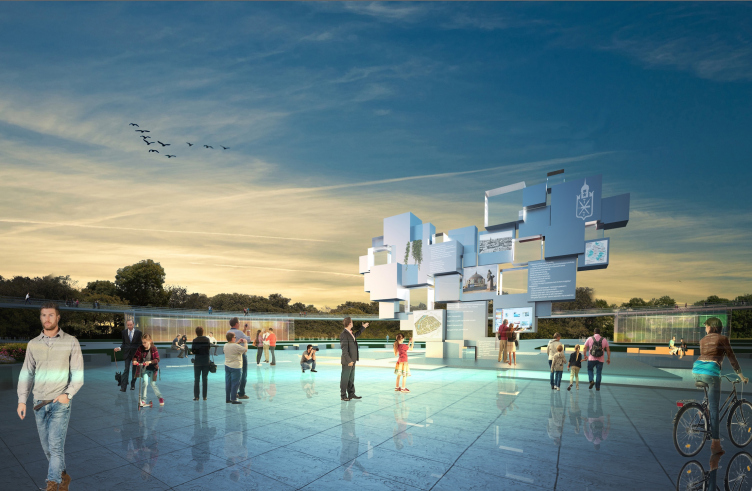One has to admit that the small historical center of Tula looks rather sad today: old buildings and whole streets have deteriorated, some buildings have not been used for a long time, and wasteground appeared in places of completely lost landmarks. The existing public areas look untended and segmentary, there are practically no connections between them, and the city’s squares and pavements serve as improvised parking lots. Another problem is the shallowed and stagnant Upa, whose approaches were long closed for the citizens.
The concept of renovating Tula's public territories. The tasks and isues. The current situation. Project, 2015 © 4izmerenie
The concept of renovating Tula's public territories. Master plan. Project proposal. Project, 2015 © 4izmerenie
The designed territory, including the Tula Kremlin and the central city square, is a lot, bounded by an extended and irregular hoop of Sovetskaya Street on the one side, and by the embankment area of the river – on the other. Within the defined boundaries, the architects suggested arranging a continuous pedestrian route, meant to unite all the significant spots of the historical center.
The concept of renovating Tula's public territories. The Soyuznaya Street. The current situation. Project, 2015 © 4izmerenie
The concept of renovating Tula's public territories. The Soyuznaya Street. The current situation. Project proposal, 2015 © 4izmerenie
Soyuznaya Street, leading to the Kremlin, became the main pedestrian boulevard in the project. Here, besides the complex embellishment – planting of trees and flowers, sidewalk paving and street furniture – the architects proposed to renovate the existing houses and fill the wasteground with low-rise buildings of new hotels and apartment units. A similar scenario was proposed for the most of the remaining streets of Tula’s central part, where the built-up density is rather low. In summer, the boulevard is to be full of life: tourists, bike riders, street cafés. In the project, traffic on the adjoining streets and lanes is one-way. Besides, having narrowed down the traffic area on Blagoveschenskaya Street, in Blagoveschensky, Soyuzny and Denisovskiy Lanes, the authors broadenned the sidewalks, thus findng room for bike paths, bushes and green lawns.
The concept of renovating Tula's public territories. The Blagoveshchenskaya Street. The current situation. Project, 2015 © 4izmerenie
The concept of renovating Tula's public territories. The Blagoveshchenskaya Street. The current situation. Project proposal, 2015 © 4izmerenie
The concept of renovating Tula's public territories. The Metallistov Street. The current situation. Project, 2015 © 4izmerenie
The concept of renovating Tula's public territories. The Metallistov Street. The current situation. Project proposal, 2015 © 4izmerenie
The boulevard of Soyuznaya street ends with Krestovozdvizhenskaya Square. Up until 1933, a baroque church stood in the middle of it (1776-1825). When it was demolished, the square was renamed Chelyuskintsev Square; then the original name was returned, but the square itself presents a traffic circle with a parking lot by Spasskaya Tower of the Kremlin and the government house. The architects suggest recreating the Krestovozdvizhenskaya Church and turning the square into a pedestrian zone. Not far, on the corner of Revolyutsii and Mendeleeva streets, the architects plan to build the so-called “Narodny Dom” (“Community Hall”), which, by their design, should become the new cultural and educational center of Tula.
The concept of renovating Tula's public territories. The Krestovozdvizhenskaya Square. The current situation. Project, 2015 © 4izmerenie
The concept of renovating Tula's public territories. The Krestovozdvizhenskaya Square. The current situation. Project proposal, 2015 © 4izmerenie
The key task of the project is to bring back the Upa river to the city. Bifurcating, the river forms a prolonged island at the north wall of the Kremlin, just like in Moscow or in Paris. However, despite the whole attractiveness of the riverside landscape, the embankment zone, built-up with industrial facilities, is completely fenced off. In the project, the riverbed is made wider and cleaned, and the riverside territories are vacated, and along the whole river, within the boundaries of the historical center, there is a landscape eco-garden with a beach, a boating station, green embankment, a wooden strand and recreational areas by the water. In winter, it can be turned into a big skating-rink.
The concept of renovating Tula's public territories. The Kremlin Embankment. The current situation. Project proposal, 2015 © 4izmerenie
Two pedestrian bridges are built across the river – they connect the pedestrian areas and embankments of the right and the left river-banks of the Upa. The new bridge, in place of the old Chulkovsky Bridge, was designed in the style proposed by the authors for Tulskaya metro station in Moscow. The constructions interpret the image of the Tula accordion, and from the distance, they remind a sceleton of giant fish. Despite the boldness of this solution, with this new bridge, which the authors called “Harmonic”, they aim to preserve the memory of this place, by using the remained substructions of the old ruined bridge at the foundation of the construction. The second “Harmonic Bridge” is planned to be built along the existing road bridge, extending the line of Sovetskaya Street. On the north-eastern bank, opposite the Kremlin, another green embankment is forming, and at a distance, the authors plan construction of a modern business quarter.
The concept of renovating Tula's public territories. The Embankment of the Upa River. The current situation. Project, 2015 © 4izmerenie
The concept of renovating Tula's public territories. The Embankment of the Upa River. The pedestrian bridge. Project proposal, 2015 © 4izmerenie
Having covered the whole historical part of Tula in their project, the architects also wondered, how they could link it with the P.P. Belousov Central Park and Arts Square in front of the park entrance. This link is to be achieved through sidewalks and bike-paths along Engels Street. Besides, the authors schedule an additional tramway stop by Arts Square, which is ntended to be the main scene of action. Currently blocked by auto barriers and occupied with cars, by design it should turn into a lively place. The parking lots are not eliminated – instead, they are placed along the perimeter, to vacate the central part for city programs and events. The square is equipped with transformer-platforms for competitions, concerts and festivals: in closed position they can serve as a base for installations and exhibitions. On weekends, the square can turn into a market, and in witer time – a skating rink.
The concept of renovating Tula's public territories. The Square of Arts. Entrance to the Byelorussy Park. Project, 2015 © 4izmerenie
The concept of renovating Tula's public territories. The Square of Arts. Entrance to the Byelorussy Park. Project proposal, 2015 © 4izmerenie
The concept of renovating Tula's public territories. The Square of Arts. City festival. Project proposal, 2015 © 4izmerenie
The concept of renovating Tula's public territories. The Square of Arts. The skating rink. Project proposal, 2015 © 4izmerenie
The concept of renovating Tula's public territories. The Square of Arts. Marketplace. Project proposal, 2015 © 4izmerenie
The diagonal paving of Arts Square with built-in LED lighting indicates the entrance to the park. Its entrance area is an ensamble of four compact wooden pavilions, whose facades present large letters. From the side of the square, the letters form the word “park”, and from the park-side – the word “Tula”. Inside the pavilions, there are cash desks, bycicle rental, an info point and a souvenir shop. As for the park itself, the architects proposed to modernize and functionally enrich it, preserving its unique eco-system, the birch grove and woodland. The chief attraction of the park should be an art-object – a big heart made of metal and translucent elements. If you come closer, on the multiple facets and surfaces of the symbolic “heart” of Tula, you will find navigating screens, see the historical panoramas of the city, read various proverbs, sayings and stories about Tula, or learn about famous people born here.
The concept of renovating Tula's public territories. "Heart of Tula" at the Central Square next to the Byelorussky Park. Project proposal, 2015 © 4izmerenie
The authors of the project admit, that they have explored Tula and came to love it. They find it a city with great potential and the future tourist gem of Central Russia. But the city has to be dealt with comprehensively, not selectively – the authors say. That is why they went far beyond the task of the contest and had a look at the city center in broader context, but at the same time – in detail.

